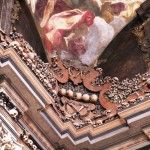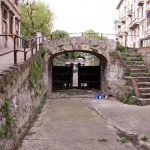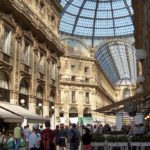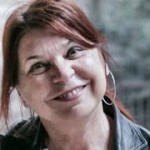The decorative charnel house and the Basilica of St. Stefano
Milan: San Maurizio
A monastery filled with art treasures
The Church of San Maurizio al Monastero Maggiore is some kind of Milan’s own “Sistine Chapel”, with almost 4000 square meters of renovated frescoes in the Benedectine Monastery, painted by some of Milan’s and Lombardy’s most famous 16th-century artists, like Bernardino Luini.
Discover the history of the Abbess who led the Monastry and its wide religious community and what does Leonardo Da Vinci have to do with all that.
⇒ Watch the full web serie Milan & Leonardo da Vinci
Cover pic courtesy of Turismo Milano official website
Video full text: San Maurizio
San Maurizio! The totem tells me precisely where I am and what it is.
The QR code then provides an explanation in 9 languages.
I’ve read the Italian version and I note that renovation work only finished recently.
The main monastery, with its almost 4000 square meters of renovated frescoes,
is Milan’s own Sistine Chapel. Truly beautiful, totally frescoed.
This was a monastery of the Benedictine Nuns of Milan.
You can tell that because it is divided by a grille.
On this side were the faithful and those coming to visit the nuns,
meanwhile the nuns had to stay on the other side.
It was a cloistered monastery.
Construction of the church, which is now a gallery containing portraits of Milan’s 16th-century nobility, began in 1503.
It was painted by some of Milan’s and Lombardy’s most famous 16th-century artists.
First and foremost by Bernardino Luini and his studio,
one of Leonardo da Vinci’s most important pupils.
Here he is! There are always traces of Leonardo.
It was Milan’s largest convent for centuries,
because it possessed so many pieces of land that were given as a dowry along with the nuns.
It was the most important because the Abbess was a very powerful woman.
She was the only female to sit on the ecclesiastical council,
which decided how the Church of Milan’s assets and its bequests and legacies should be managed.
The Abbess wielded great power!
What we have here is an example, because there was enough money to pay all these artists.
We can see Alessandro Bentivoglio and Ippolita Sforza in the lunettes,
accompanied by their daughter, who was to become the Abbess.
Ippolita Sforza Bentivoglio was a noblewoman of Milan
who rubbed shoulders with the most important artists, which included Luini himself.
She is dressed exorbitantly, which shows that fashion existed then as well!
As it happens the fashion of those little bows is actually that launched by Leonardo.
The dress, kept together with so many bows, also has the puffed up sleeves.
Then there’s that frivolous hat. She was beautiful, rich and powerful.
You may have a mystical name Maria, but fortunately we don’t have to enter the convent!
But let’s go and look at the other side, that was only used by the nuns.
How lovely! These are the benches where the nuns sat.
These stalls are still used, for example, when there is a concert.
There are so many places, almost 100.
Just goes to show how large the religious community of San Maurizio actually was.
Then there is a magnificent organ,
Because the nuns would play music and sing.
This part in the partition was also frescoed by Bernardino Luini,
and his sons, who worked in his studio, frescoed the side chapels.
The other side shows the clients,
who had to appear before the faithful in all their splendour and riches.
The chapels depict some landscapes, very reminiscent of Leonardo’s,
that would help the nuns to meditate.
The lunettes, containing frescoes depicting scenes from the passion of Christ,
would help the nuns to pray.
They really couldn’t see over there from here.
When Charles Borromeo visited the convent
he decided to reduce the size of this grille, which was larger at the time, still further.
There’s a Last Supper painted by Luini’s sons,
which is greatly influenced by Leonardo’s own Last Supper.
Below is the door that the nuns used for climbing to the top of the tower.
The tower is the steeple that leans against the wall dating from Roman times,
as does the entire convent. So, here we are!
Milan, seen from the top. From here you can see the polygonal tower from the imperial age.
Here are all the ancient Roman columns that were reused to build the upper part of this tower.
This was the entrance to the ancient Roman medio lanum, the Roman circus that was located here.
It comes from the legend of the medio lanuta sow, found here by the Celtic King, Bellovesus.
He arrived here and decided to found medio lanum,
that is a reminder of the medio-lanuta or partially fleece-covered sow.
With that he made a coat, and so Milan’s world of fashion began,
with the fleece of the semi-lanuta sow!
In reality medio lanum means “being at the centre”,
of the plain, of the waters and of the world by importance!
That’s precisely how you Milanese are.
This was the hamlet that took its name from the church of Santa Maria delle Grazie.
Where the refectory houses the Last Supper.
Here we find a copy painted by a student, son of a student,
an admirer, in some way, of Leonardo da Vinci.
The real Last Supper is over there… can we see it?
Not just in a souvenir or on a post card, but the real thing!
Visit Milan: helpful hints
Italian name: Milano
Arrival
Milan has got three airports:
- Malpensa Airport is the largest international & intecontinental Airport in Northern Italy. 30 miles Northwest from the city centre. Connections:
→ Train Malpensa Express: trains leaves every 30 minutes in each direction, connecting the Airport to Milan Grand Central Station or Cadorna Railway Station. Terminals 1 and 2. It takes 45 min, price: 14 €
→ Shuttle Bus: Malpensa Shuttle and Malpensa Bus Express connect the airport to Milan Grand Central Railway Station and Milan’s Underground Network. Terminals 1 and 2. It takes 60/70 min, price: 8 € - City Airport Linate is an international airport connecting Milan with main European cities, located just 4 miles from the city centre. Connections by shuttle: Atm Bus n. 73 from Milano Duomo M1 – M3 (Piazza Diaz, direction: San Babila), first ride at 5.35 am, last one at 00.35. Frequency: every 10 min, price 1,5 €
- Milan Bergamo Airport Orio al Serio is mainly low cost flights Airport, located 30 miles Northwest from Milan. Connections only by Shuttle: There are 4 different bus companies, pricing changes from 5 up to 8 €
Transports
ATM is Milan public transport service both for bus, tram and subway. Single ticket costs 1.50€ for 90-min ride. Consider daily/weekly subscriptions. You can buy tickets also texting to 48444. Milan Subway is the longest in Italy, covering 95 km: Donwload and check the map.
Moving in town can be nice also by bike: Milan has got a powerfull bike sharing service providing both regular and e-bikes. Here is the experience of our Ambassador Kim Harding with BikeMi service and a useful video of our Ambassador Roxana explaining how does it work. Car Sharing is also good with many different companies to choose.
Try also the local urban railway train, called Passante Ferroviario, check the experience of our Ambassador Roxana Iacoban travelling by local train in town.
What to do in Milan
Milan is the Italian financial center and one of the European capitals of Fashion. Known for its nightlife as well.
Some tips on Italia Slow Tour: watch our web serie about Leonardo da Vinci’s places, climb on top of the Duomo, visit Prada Foundation, Museums and Art Galleries, taste some fine gelato and try the local Aperitivo and – not joking – enjoy a sailing trip (!!) or some time deep in the nature close to some actual farms and fields.
Where to sleep
Accomodations are quite expensive in Milan, fares rise up and hotels get full according to the rich event calendar of the city (see: Fashion Week, Salone del mobile, Big concerts, Theatre and Sport events, etc.). If you are not specifically interested in any of those, try to travel during other periods to save some money.
Italia Slow Tour recommends:
- Hotel Cervo in Garibaldi District if you want to stay close to city centre and enjoy the nightlife
- Hotel Concorde located on the Green Way Milan-Lecco to Lake Como, if you want to move around adn travel by bike
Shopping in Milan
The famous Fashion District involves the following streets/areas: Via Montenapoleone, via Manzoni, via della Spiga and Corso Venezia. The so called “Quadrilateral of Fashion”. Here you can find all kind of brands and shops. Easy to reach by Subway (stop at Montenapoleone station).
Don’t miss the Street Markets! Almost every day you can find one: best are the ones in Viale Papiniano (on Tuesday) and Via Fauchè (on Saturday). More on the official website of weekly street markets. If you are into sustainable local products, Milan has got 8 actual farms in town and a green Earth Market.
If you are interested in Outlet Shopping, in the outskirt of Milan you can find 4 different Fashion Outlets, in a radius of 62 miles. Here you can find everyday a lot of famous high quality Italian brands on sale, with prices cut off up to 50%. All the outlets are connected to the center of Milan by Shuttle Bus:
- Serravalle Designer Outlet – Shuttle departure from Milan Central Station or Cairoli square
- Fidenza Village Outlet Shopping – Shuttle departure from Piazza della Repubblica 5, at the corner with Turati st.
- Vicolungo The Style Outlets – Shuttle departure from Cairoli square
- Rodengo-Saiano Franciacorta Outlet Village – Shuttle departure from Cairoli square















1 Comment
Il mio Slow Tour a Milano | Nomadizziamoci
[…] San Maurizio, la “Cappella Sistina” di Milano […]